Porous Coatings to Control Release Rates of Essential Oils to Generate an Atmosphere with Botanical Actives
Abstract
:1. Introduction
2. Materials and Methods
2.1. Chemicals
2.2. Preparation of the FCC Film
2.3. Loading of EO on PET Foils
2.4. Release Experiments Using Gravimetrical Analysis
2.5. Release Experiments Using Mass Spectrometry
3. Results
3.1. Theoretical Considerations
3.2. Release of EO
3.3. Equilibrium Vapor Pressure in Confined Space
4. Discussion
4.1. Kinetics of EO Release
4.2. Composition of the Released EO
4.3. Controlling the Release of EO
5. Conclusions
- Porous coatings made of FCC are ideal carriers for EO to be released into vapor phase. This application could be more beneficial to use for confined spaces where the release of EO can be controlled such as packages, containers and bottles that present a sealing system.
- For both EO systems analyzed, rosemary and thyme, it was observed that rosemary reached faster the equilibrium of saturation in the vapor phase compared to thyme, which required almost double the time to be in the saturation point. A possible explanation for this effect is the different chemical composition of the EO. Instead of a liquid film, a dry surface is present on the coating, while the pore structure fixes the EO. The EO evaporates out of the pores and into the vapor phase and is distributed into the atmosphere.
- The release can be controlled by the degree of loading dependent on the EO used. This allows tailor-made solutions for a broad range of applications with control over the equilibrium concentrations and release kinetics.
- The results of this study also create new questions to be answered in future studies. The present study mainly focuses on the physical influences on the release, and the influence of the essential oil chemistry could not be resolved. More studies on the chemical composition of the vapor and the influence of the chemical composition of the essential oils on the release kinetics would complement the results of this study and complete the assessment of the controlling parameters.
Author Contributions
Funding
Informed Consent Statement
Data Availability Statement
Conflicts of Interest
References
- Farag, R.; Salem, H.; Badei, A.; Hassanein, D. Biochemical studies on the essential oils of some medicinal plants. Fette Seifen Anstrichm. 1986, 88, 69–72. [Google Scholar] [CrossRef]
- Farag, R.; Daw, Z.; Hewedi, F.; El-Baroty, G. Antimicrobial activity of some Egyptian spice essential oils. J. Food Prot. 1989, 52, 665–667. [Google Scholar] [CrossRef] [PubMed]
- Bosnić, T.; Softić, D.; Grujić-Vasić, J. Antimicrobial activity of some essential oils and major constituents of essential oils. Acta Med. Acad. 2006, 35, 9–14. [Google Scholar]
- Yildirim, S.; Röcker, B. Sustainable antimicrobial packaging technologies. In Sustainable Food Packaging Technology; Wiley: New York, NY, USA, 2021; pp. 323–348. [Google Scholar]
- Isman, M.B.; Miresmailli, S. Plant essential oils as repellents and deterrents to agricultural pests. In Recent Developments in Invertebrate Repellents; ACS Publications: Washington, DC, USA, 2011; pp. 67–77. [Google Scholar]
- Regnault-Roger, C.; Hemetsberger, S.; Buchbauer, G. Use of Essential Oils in Agriculture. In Handbook of Essential Oils; CRC Press: Boca Raton, FL, USA, 2020; pp. 873–917. [Google Scholar]
- Zhai, H.; Liu, H.; Wang, S.; Wu, J.; Kluenter, A.-M. Potential of essential oils for poultry and pigs. Anim. Nutr. 2018, 4, 179–186. [Google Scholar] [CrossRef] [PubMed]
- Shimelis, N.D.; Asticcioli, S.; Baraldo, M.; Tirillini, B.; Lulekal, E.; Murgia, V. Researching accessible and affordable treatment for common dermatological problems in developing countries. An Ethiopian experience. Int. J. Dermatol. 2012, 51, 790–795. [Google Scholar] [CrossRef] [PubMed]
- Tongnuanchan, P.; Benjakul, S. Essential oils: Extraction, bioactivities, and their uses for food preservation. J. Food Sci. 2014, 79, R1231–R1249. [Google Scholar] [CrossRef]
- Hyldgaard, M.; Mygind, T.; Meyer, R.L. Essential oils in food preservation: Mode of action, synergies, and interactions with food matrix components. Front. Microbiol. 2012, 3, 12. [Google Scholar] [CrossRef] [Green Version]
- Sharma, S.; Barkauskaite, S.; Jaiswal, A.K.; Jaiswal, S. Essential oils as additives in active food packaging. Food Chem. 2020, 2020, 128403. [Google Scholar] [CrossRef]
- Ribeiro-Santos, R.; Andrade, M.; de Melo, N.R.; Sanches-Silva, A. Use of essential oils in active food packaging: Recent advances and future trends. Trends Food Sci. Technol. 2017, 61, 132–140. [Google Scholar] [CrossRef]
- Maisanaba, S.; Llana-Ruiz-Cabello, M.; Gutiérrez-Praena, D.; Pichardo, S.; Puerto, M.; Prieto, A.; Jos, A.; Cameán, A. New advances in active packaging incorporated with essential oils or their main components for food preservation. Food Rev. Int. 2017, 33, 447–515. [Google Scholar] [CrossRef]
- Food and Agriculture Organization of the United Nations. Food Wastege Footprint Impacts on Natural Resources. Available online: www.fao.org/publications (accessed on 1 March 2022).
- Becerril, R.; Nerín, C.; Silva, F. Encapsulation systems for antimicrobial food packaging components: An update. Molecules 2020, 25, 1134. [Google Scholar] [CrossRef] [Green Version]
- World Health Organization. WHO Estimates of the Global Burden of Foodborne Diseases: Foodborne Disease Burden Epidemiology Reference Group 2007–2015; World Health Organization: Geneva, Switzerland, 2015. [Google Scholar]
- Chamorro, E.R.; Zambón, S.N.; Morales, W.G.; Sequeira, A.F.; Velasco, G.A. Study of the chemical composition of essential oils by gas chromatography. Gas Chromatogr. Plant Sci. Wine Technol. Toxicol. Some Specif. Appl. 2012, 1, 307–324. [Google Scholar]
- Franz, C.; Novak, J. Sources of essential oils. In Handbook of Essential Oils; CRC Press: Boca Raton, FL, USA, 2020; pp. 41–83. [Google Scholar]
- Rüegg, N.; Beck, B.M.; Monnard, F.W.; Hilty, F.M.; Wicht, A.; Schoelkopf, J.; Yildirim, S. Evaluation of the potential of functionalised calcium carbonate as carrier for essential oils with regard to antimicrobial packaging applications. Packag. Technol. Sci. 2020, 33, 333–343. [Google Scholar] [CrossRef]
- Florindo, C.; Lima, F.; Ribeiro, B.D.; Marrucho, I.M. Deep eutectic solvents: Overcoming 21st century challenges. Curr. Opin. Green Sustain. Chem. 2019, 18, 31–36. [Google Scholar] [CrossRef]
- Liu, Y.; Friesen, J.B.; McAlpine, J.B.; Lankin, D.C.; Chen, S.-N.; Pauli, G.F. Natural deep eutectic solvents: Properties, applications, and perspectives. J. Nat. Prod. 2018, 81, 679–690. [Google Scholar] [CrossRef]
- Thananukul, K.; Kaewsaneha, C.; Opaprakasit, P.; Lebaz, N.; Errachid, A.; Elaissari, A. Smart gating porous particles as new carriers for drug delivery. Adv. Drug Deliv. Rev. 2021, 174, 425–446. [Google Scholar] [CrossRef]
- Ahuja, G.; Pathak, K. Porous carriers for controlled/modulated drug delivery. Indian J. Pharm. Sci. 2009, 71, 599. [Google Scholar] [CrossRef] [Green Version]
- Horcajada, P.; Chalati, T.; Serre, C.; Gillet, B.; Sebrie, C.; Baati, T.; Eubank, J.F.; Heurtaux, D.; Clayette, P.; Kreuz, C. Porous metal–organic-framework nanoscale carriers as a potential platform for drug delivery and imaging. Nat. Mater. 2010, 9, 172–178. [Google Scholar] [CrossRef]
- Liao, L.; Meng, Y.; Wang, R.; Jia, B.; Li, P. Coupling and regulation of porous carriers using plasma and amination to improve the catalytic performance of glucose oxidase and catalase. Front. Bioeng. Biotechnol. 2019, 7, 426. [Google Scholar] [CrossRef] [Green Version]
- Arruebo, M. Drug delivery from structured porous inorganic materials. Wiley Interdiscip. Rev. Nanomed. Nanobiotechnol. 2012, 4, 16–30. [Google Scholar] [CrossRef]
- Kuorwel, K.K.; Cran, M.J.; Sonneveld, K.; Miltz, J.; Bigger, S.W. Essential oils and their principal constituents as antimicrobial agents for synthetic packaging films. J. Food Sci. 2011, 76, R164–R177. [Google Scholar] [CrossRef] [Green Version]
- Carpena, M.; Nuñez-Estevez, B.; Soria-Lopez, A.; Garcia-Oliveira, P.; Prieto, M.A. Essential oils and their application on active packaging systems: A review. Resources 2021, 10, 7. [Google Scholar] [CrossRef]
- Jin, L.; Teng, J.; Hu, L.; Lan, X.; Xu, Y.; Sheng, J.; Song, Y.; Wang, M. Pepper fragrant essential oil (PFEO) and functionalized MCM-41 nanoparticles: Formation, characterization, and bactericidal activity. J. Sci. Food Agric. 2019, 99, 5168–5175. [Google Scholar] [CrossRef]
- Gao, F.; Zhou, H.; Shen, Z.; Zhu, G.; Hao, L.; Chen, H.; Xu, H.; Zhou, X. Long-lasting anti-bacterial activity and bacteriostatic mechanism of tea tree oil adsorbed on the amino-functionalized mesoporous silica-coated by PAA. Colloids Surf. B Biointerfaces 2020, 188, 110784. [Google Scholar] [CrossRef]
- Xiao, Z.; Bao, H.; Jia, S.; Bao, Y.; Niu, Y.; Kou, X. Organic Hollow Mesoporous Silica as a Promising Sandalwood Essential Oil Carrier. Molecules 2021, 26, 2744. [Google Scholar] [CrossRef]
- Elabbadi, A.; Jerri, H.A.; Ouali, L.; Erni, P. Sustainable delivery systems: Retention of model volatile oils trapped on hybrid calcium carbonate microparticles. ACS Sustain. Chem. Eng. 2015, 3, 2178–2186. [Google Scholar] [CrossRef]
- Sircar, S. Linear-driving-force model for non-isothermal gas adsorption kinetics. J. Chem. Soc. Faraday Trans. 1 Phys. Chem. Condens. Ph. 1983, 79, 785–796. [Google Scholar] [CrossRef]
- Webb, S.W.; Pruess, K. The use of Fick’s law for modeling trace gas diffusion in porous media. Transp. Porous Media 2003, 51, 327–341. [Google Scholar] [CrossRef]
- Glueckauf, E.; Coates, J. 241. Theory of chromatography. Part IV. The influence of incomplete equilibrium on the front boundary of chromatograms and on the effectiveness of separation. J. Chem. Soc. 1947, 1315–1321. [Google Scholar] [CrossRef]
- Sircar, S.; Hufton, J. Why does the linear driving force model for adsorption kinetics work? Adsorption 2000, 6, 137–147. [Google Scholar] [CrossRef]
- Shiue, A.; Kang, Y.-H.; Hu, S.-C.; Jou, G.-T.; Lin, C.-H.; Hu, M.-C.; Lin, S.-I. Vapor adsorption characteristics of toluene in an activated carbon adsorbent-loaded nonwoven fabric media for chemical filters applied to cleanrooms. Build. Environ. 2010, 45, 2123–2131. [Google Scholar] [CrossRef]
- Joly, A.; Perrard, A. Linear driving force models for dynamic adsorption of volatile organic compound traces by porous adsorbent beds. Math. Comput. Simul. 2009, 79, 3492–3499. [Google Scholar] [CrossRef]
- Benham, M.; Ross, D. Experimental determination of absorption-desorption isotherms by computer-controlled gravimetric analysis. Z. Für Phys. Chem. 1989, 163, 25–32. [Google Scholar] [CrossRef]
- Stull, D.R. Vapor pressure of pure substances. Organic and inorganic compounds. Ind. Eng. Chem. 1947, 39, 517–540. [Google Scholar] [CrossRef]
- Don, W.G.; Marylee, Z.S. Perry’s Chemical Engineers’ Handbook; McGraw-Hill Education: New York, NY, USA, 2019. [Google Scholar]
- Yao, G.; Wang, L.; Chen, X.; Liao, D.; Wei, X.; Liang, J.; Tong, Z. Measurement and correlation of vapor–liquid equilibrium data for binary and ternary systems composed of (−)-β-caryophyllene, p-cymene and 3-carene at 101.33 kPa. J. Chem. Thermodyn. 2019, 128, 215–224. [Google Scholar] [CrossRef]
- Horst, R. Calculation of vapor pressures not requiring the derivatives of the energy of mixing. Macromol. Theory Simul. 1997, 6, 427–435. [Google Scholar] [CrossRef]
- Evans, R. Fluids adsorbed in narrow pores: Phase equilibria and structure. J. Phys. Condens. Matter 1990, 2, 8989. [Google Scholar] [CrossRef]
- Searcy, A.W.; Ragone, D.V.; Colombo, U. Chemical and mechanical behavior of inorganic materials. Accademia Nazionale dei Lincei Eleventh Course of the Guido Donegani Foundation, Tremezzo (Lake Como), Italy, 8–20 September 1968. 1970. Available online: https://www.osti.gov/biblio/4027277 (accessed on 1 March 2022).
- KočiŘik, M.; Zikánová, A. The analysis of the adsorption kinetics in materials with polydisperse pore structure. Ind. Eng. Chem. Fundam. 1974, 13, 347–350. [Google Scholar] [CrossRef]
- Polikarpov, A.P.; Graur, I.; Gatapova, E.Y.; Kabov, O. Kinetic simulation of the non-equilibrium effects at the liquid-vapor interface. Int. J. Heat Mass Transf. 2019, 136, 449–456. [Google Scholar] [CrossRef]
- Gu, J.; Bart, H.-J. Heat and mass transfer in steam desorption of an activated carbon adsorber. Int. Commun. Heat Mass Transf. 2005, 32, 296–304. [Google Scholar] [CrossRef]
- Hazra, A.; Alexander, K.; Dollimore, D.; Riga, A. Characterization of some essential oils and their key components: Thermoanalytical techniques. J. Therm. Anal. Calorim. 2004, 75, 317–330. [Google Scholar] [CrossRef]
- Cornelissen, G.; van Noort, P.C.; Parsons, J.R.; Govers, H.A. Temperature dependence of slow adsorption and desorption kinetics of organic compounds in sediments. Environ. Sci. Technol. 1997, 31, 454–460. [Google Scholar] [CrossRef] [Green Version]
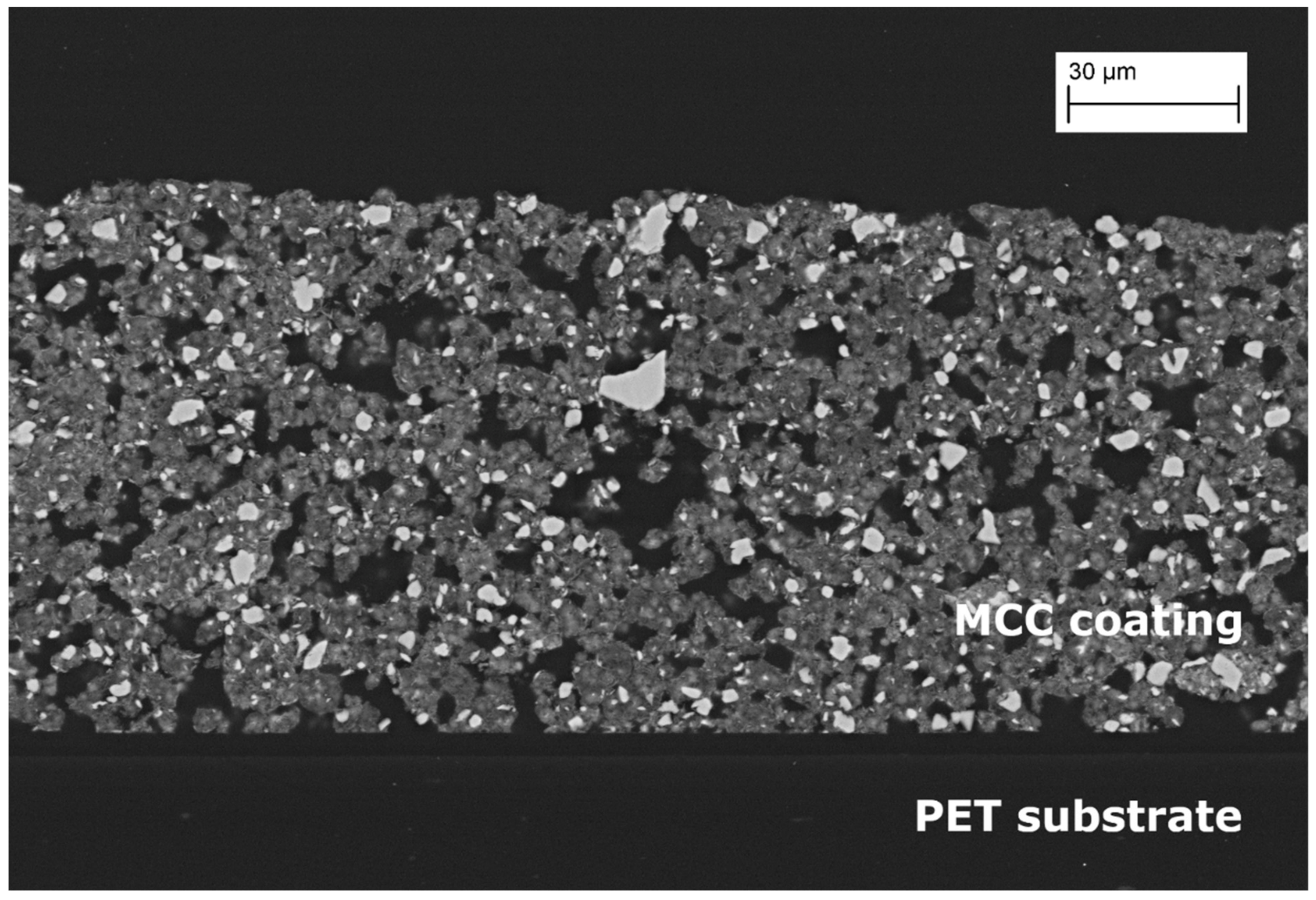
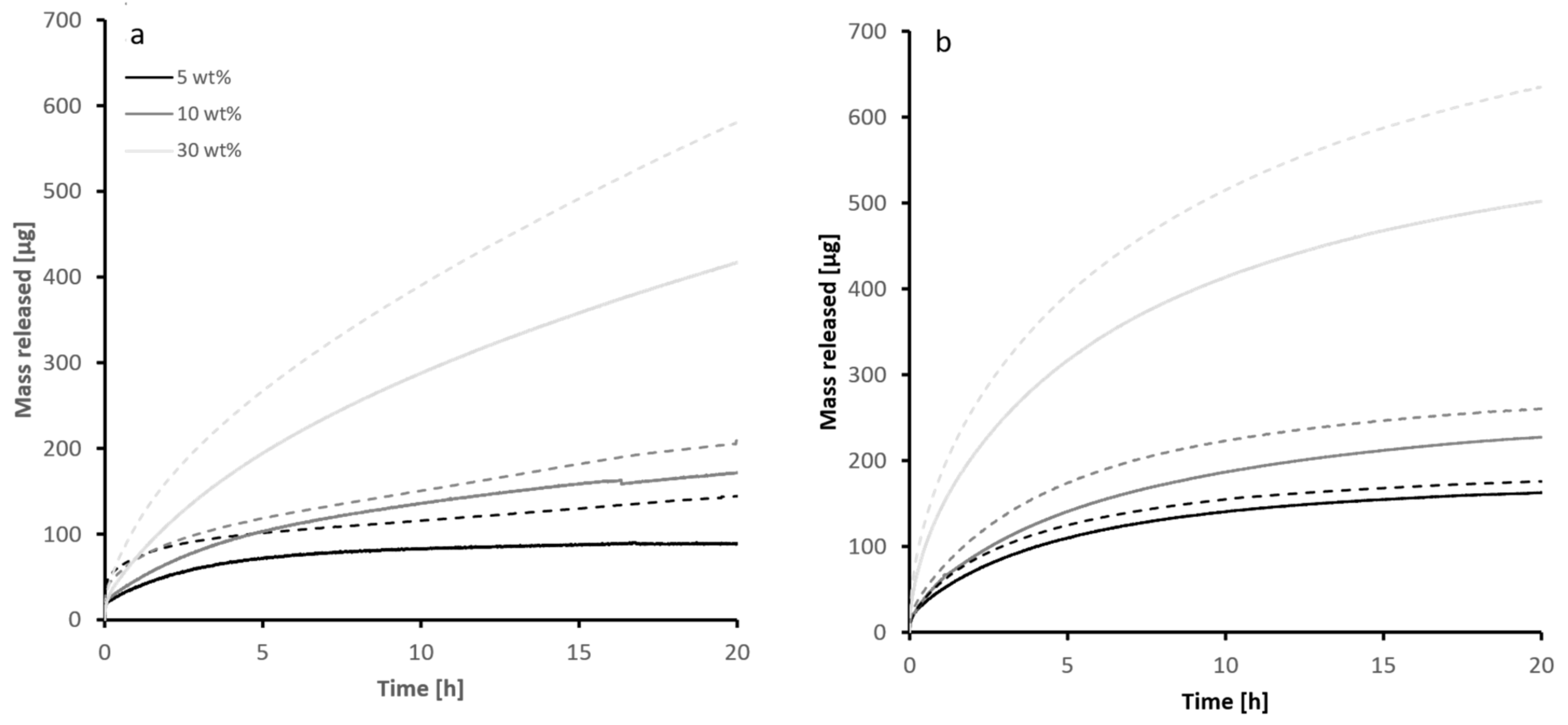
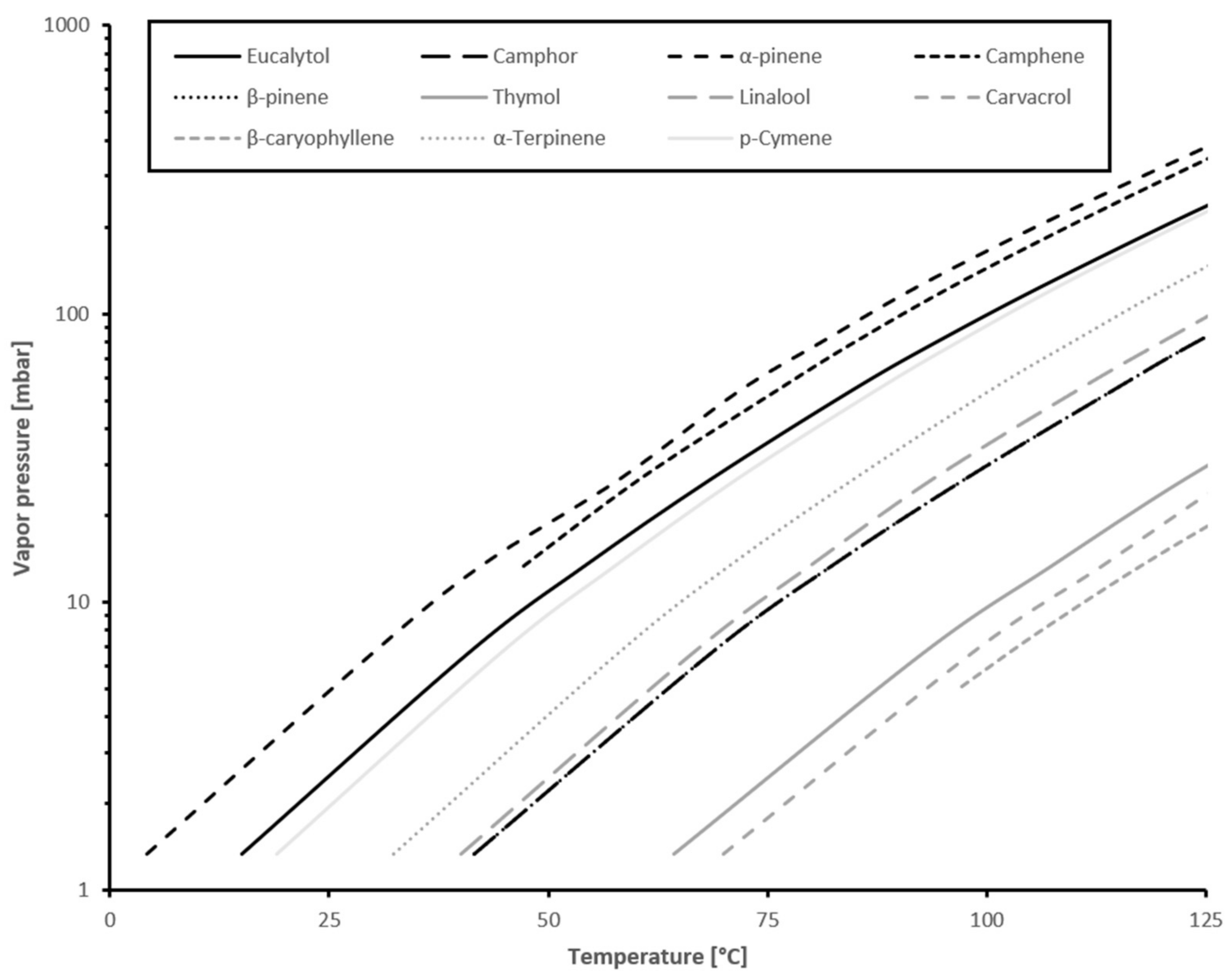

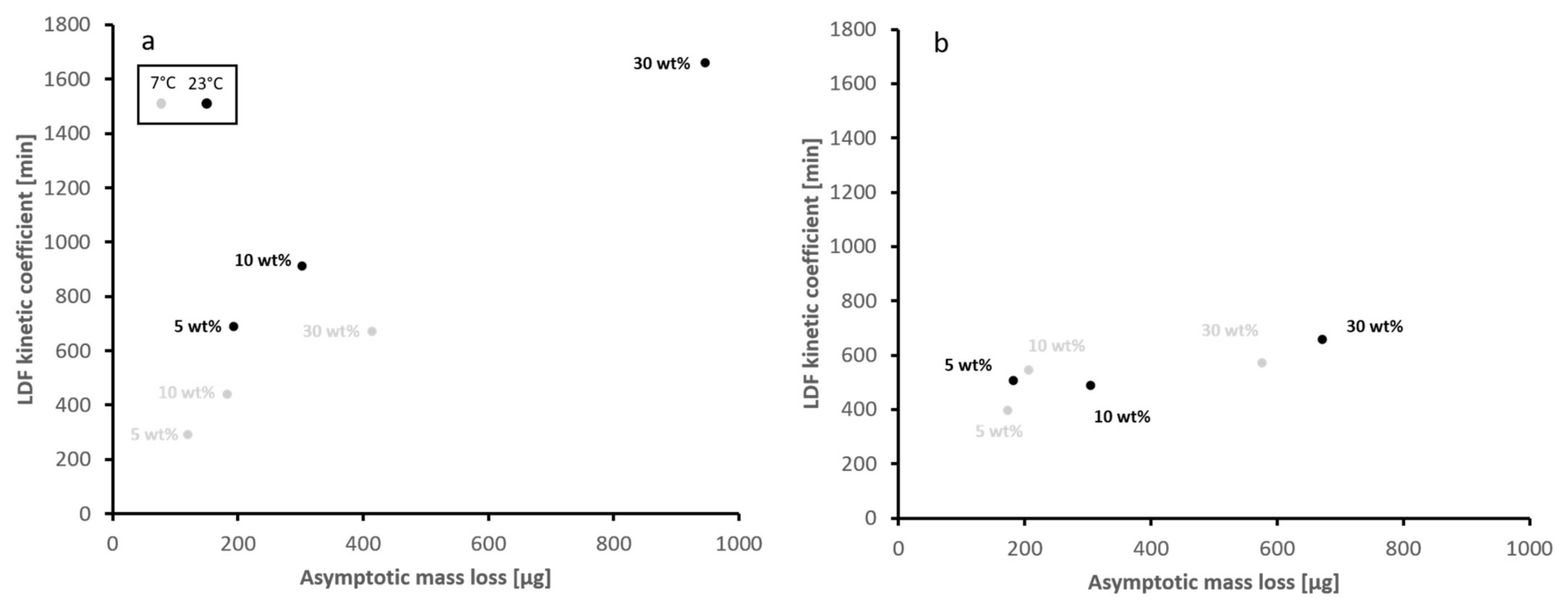

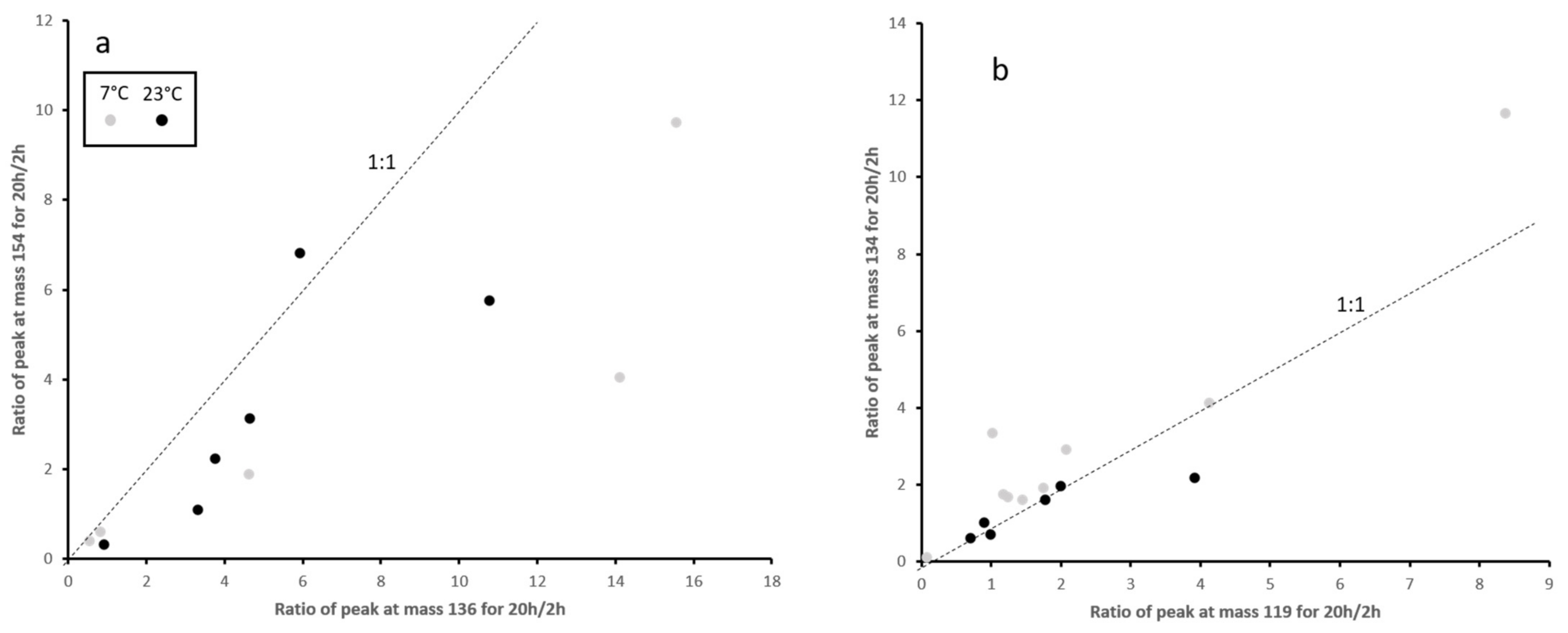
| Plant/Components | Rosmarinus Officinalis (Rosemary) [%] | Thymus Officinalis (Thyme) [%] |
|---|---|---|
| Eucalyptol | 46.85 (±0.47) | 0.80 (±0.05) |
| Camphor | 16.79 (±0.24) | - |
| α-Pinene | 9.49 (±0.33) | 1.21 (±0.03) |
| Camphene | 4.04 (±0.08) | 0.94 (±0.02) |
| β-Pinene | 4.26 (±0.12) | 1.28 (±0.01) |
| Thymol | - | 50.28 (±0.35) |
| p-Cymene | 3.03 (±0.07) | 21.73 (±0.07) |
| γ-Terpinene | 0.10 (±0.01) | 8.89 (±0.14) |
| Linalool | 0.84 (±0.02) | 3.25 (±0.06) |
| Carvacrol | - | 4.51 (±0.05) |
| β-Caryophyllene | - | 1.14 (±0.03) |
Publisher’s Note: MDPI stays neutral with regard to jurisdictional claims in published maps and institutional affiliations. |
© 2022 by the authors. Licensee MDPI, Basel, Switzerland. This article is an open access article distributed under the terms and conditions of the Creative Commons Attribution (CC BY) license (https://creativecommons.org/licenses/by/4.0/).
Share and Cite
Hettmann, K.; Monnard, F.W.; Melo Rodriguez, G.; Hilty, F.M.; Yildirim, S.; Schoelkopf, J. Porous Coatings to Control Release Rates of Essential Oils to Generate an Atmosphere with Botanical Actives. Materials 2022, 15, 2155. https://doi.org/10.3390/ma15062155
Hettmann K, Monnard FW, Melo Rodriguez G, Hilty FM, Yildirim S, Schoelkopf J. Porous Coatings to Control Release Rates of Essential Oils to Generate an Atmosphere with Botanical Actives. Materials. 2022; 15(6):2155. https://doi.org/10.3390/ma15062155
Chicago/Turabian StyleHettmann, Kai, Fabien W. Monnard, Gabriela Melo Rodriguez, Florentine M. Hilty, Selçuk Yildirim, and Joachim Schoelkopf. 2022. "Porous Coatings to Control Release Rates of Essential Oils to Generate an Atmosphere with Botanical Actives" Materials 15, no. 6: 2155. https://doi.org/10.3390/ma15062155
APA StyleHettmann, K., Monnard, F. W., Melo Rodriguez, G., Hilty, F. M., Yildirim, S., & Schoelkopf, J. (2022). Porous Coatings to Control Release Rates of Essential Oils to Generate an Atmosphere with Botanical Actives. Materials, 15(6), 2155. https://doi.org/10.3390/ma15062155






